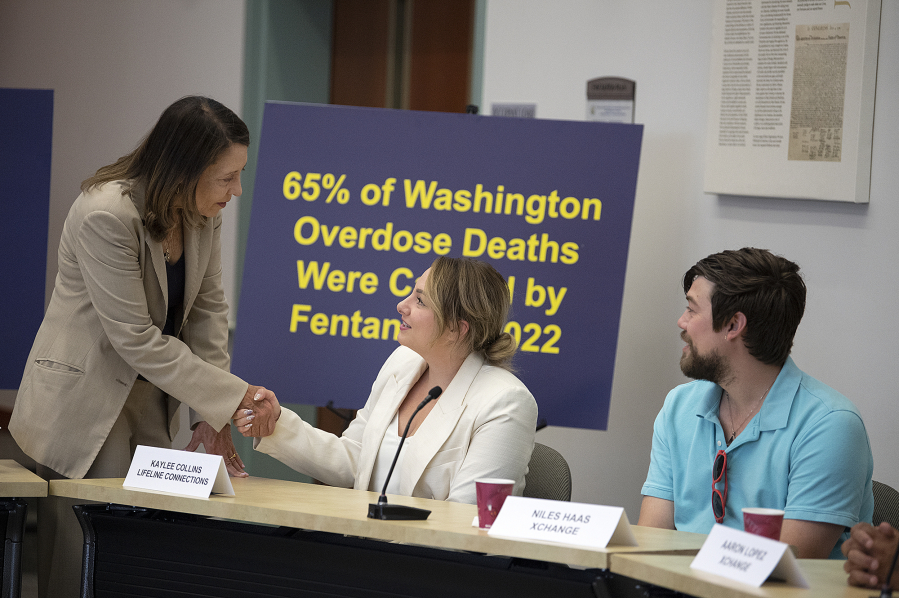It’s stronger than meth, heroin and cocaine, but one dose is only the price of a cup of coffee.
“I’ve never seen anything like it,” Aaron Lopez said. He had been addicted to fentanyl for two years before he recovered. “It was just one of the most addictive things that I’ve ever taken in my life. One hit, and I was instantly hooked.”
The drug is spreading, traveling up Interstate 5 into Clark County and killing indiscriminately.
Fentanyl has driven overdoses up 500 percent in Clark County between 2018 and 2022, leaving politicians and frontline workers scrambling for solutions. But the county is losing the race to treat fentanyl addictions as they arise.
Law enforcement, health and treatment providers, first responders and people recovered from fentanyl addiction gathered in downtown Vancouver on Monday to discuss Clark County’s fentanyl problem and solutions with Sen. Maria Cantwell, D-Wash.
Cantwell co-sponsored the FEND Off Fentanyl Act that passed last month that sanctions international fentanyl traffickers. Washington experienced the largest increase in drug overdoses last year of every U.S. state.
Those seated at the roundtable suggested increased funding, more accessibility to immediate treatment and affordable housing.
“If we can bridge this immediate crisis of housing and services, you will give these individuals the help that they need,” Vancouver Mayor Anne McEnerny-Ogle said.
It’s ‘a special kind of hell’
Aaron Lopez said that fentanyl was the “perfect drug” for him. Self-medicating from trauma caused by childhood abuse, it took away his pain.
“It went really quickly from me getting high to me just taking the drug and feeling normal,” he said. “It was a special kind of hell.”
Lopez said he was living day by day at the mercy of the drug.
“I just accepted the fact that I was going to die on the street, probably in the gutter. And a lot of the times I would use in public just for the fact that if I OD’ed, someone would find my body and tell my family what happened to me,” he said.
After his belongings were stolen, Lopez visited Living Hope Church for another sleeping bag and tent. It was there a staff member asked if he wanted help, which led him to a detox program and counseling.
Lopez has been clean for one year.
Niles Haas had a similar experience with fentanyl. At around 13 years old, Haas began taking prescribed opiates.
“It just felt amazing, because all of that compounded trauma and messed-up stuff inside of me, inside my head, it was all gone,” said Haas.
As he got older he began seeking out prescriptions. When he saw a pill on the street that looked just like the ones he took as a teenager, he took it. That was the first time he experienced fentanyl, and he didn’t stop from there.
Haas said everything began spiraling out of control quickly.
“Weeks went by, and all of a sudden my life was ruined,” said Haas. “I didn’t have a perfect life, but it was pretty good. I was with somebody I loved and cared about very much for a long time. We had a dog together, I had my cards paid off, I had a decent job and I was getting ready to buy a house.”
“And I just started morally degrading so quickly because of fentanyl.”
From there, he started isolating from family and friends, sold his possessions and started going to jail.
Haas spent the down payment he and his partner were planning to use for a house to pay for more fentanyl. During one of his stays in jail, Haas decided he wanted to get clean. He’s been sober for a year and a half.
“It’s really a combination of all these things that helped me: MAT (medicated assisted treatment) was a factor. People in treatment was a huge factor. Law enforcement was a factor, XChange was a huge factor and the backbone to my success,” Haas said. “So all these things led to me having the life that I have today.”
Health professionals at the roundtable said having immediate access is important in stories like these, but Clark County needs more funding to expand its services.
Dr. Kevin Fischer, medical director at Columbia River Mental Health Services, said the number of people seeking treatment has doubled in the last few years. According to him, lack of after-hours care and medical transportation can deter those from seeking or continuing treatment.
Fischer often sees people who complete addiction treatment and obtain a steady job, but can’t easily access medical help throughout their sobriety journey because clinics close so early.
“The very life we want people to move into becomes the barrier to access treatment and remain in sobriety,” said Fischer.
Access to treatment and the means to access are intertwined, but the transition from completing treatment to remaining sober is just as difficult.
Health professionals said Monday that many barriers continue to keep people from seeking treatment. Without access to proper housing, transportation and basic needs, those struggling with addiction cannot effectively complete or begin treatment.
Dr. Alan Melnick, Clark County Public Health director, said that there is a need for more follow-up treatment, specifically with those who are leaving incarceration.
“The biggest risk for overdose is two weeks after getting out of jail,” said Melnick. “Because you go into jail, you get detoxed, you’re taken off your medications, and then you go out and use the same amount (of drug) you were using before and die.”
Stopping supply and understanding demand
KC Kasberg, a commander at the Clark County Sheriff’s Office, said most of the fentanyl products are controlled and distributed by cartels, but there are also a significant number of dealers who are purchasing, selling and manufacturing in the community.
Last week, police seized several hundred pills and a half a pound of fentanyl powder, the equivalent of 70,000 lethal doses of the drug.
“I think there’s misconceptions that drove task forces across the state are out just to try and to get that person that’s on the corner that’s using and that’s not the case,” he said. “Our mission is to ultimately dismantle then hopefully disrupt the drug trafficking organizations that are working in our community.”
Kasberg said Cantwell has great ideas on how to secure the entire nation but there also has to be a focus on local jurisdictions. But without federal assistance, the sheriff’s office doesn’t have the funding to crack down on drug traffickers. It doesn’t even have the staffing to keep its Drug Task Force running.
Eighteen months ago, he’d say around a third of the unhoused community has substance use disorders. Now, it’s more like 60 percent.
A lack of stable housing can be a major barrier for people seeking addiction treatment, said Melnick of Clark County Public Health.
“If any of us were unhoused, we might be turning to using these substances,” he said. “We really need a Housing First model.”
Housing First is a national model where people can access housing without barriers such as sobriety or treatment beforehand.
“You can’t expect folks who are unhoused to be able to successfully participate in medication therapy or treatment, as well as counseling recovery services,” Melnick said. “You need stable housing.”
But Clark-Cowlitz Fire Rescue Chief John Nohr said fentanyl doesn’t only affect unhoused people.
He responded to a call at a resort hotel last week, where he found a 17-year-old boy performing CPR on his mother who had overdosed on fentanyl. The response team administered Narcan, which only reverses the effects of an opioid.
Youth are also at risk, said Esmeralda Garcia. As a substance use counselor at Fort Vancouver High School, Garcia has witnessed the impact of fentanyl on teens firsthand. Garcia said it’s not about the distribution of fentanyl — it’s about eliminating the demand for it.
Garcia believes that starts with improving people’s lives and acknowledging that many children are sleeping on the pavement tonight.
“I mean, if I were living some of these lives, I’d want to be high too,” Garcia said. “So that’s what I believe, as someone sitting in the muck with children, trying to pull them out one by one.”






